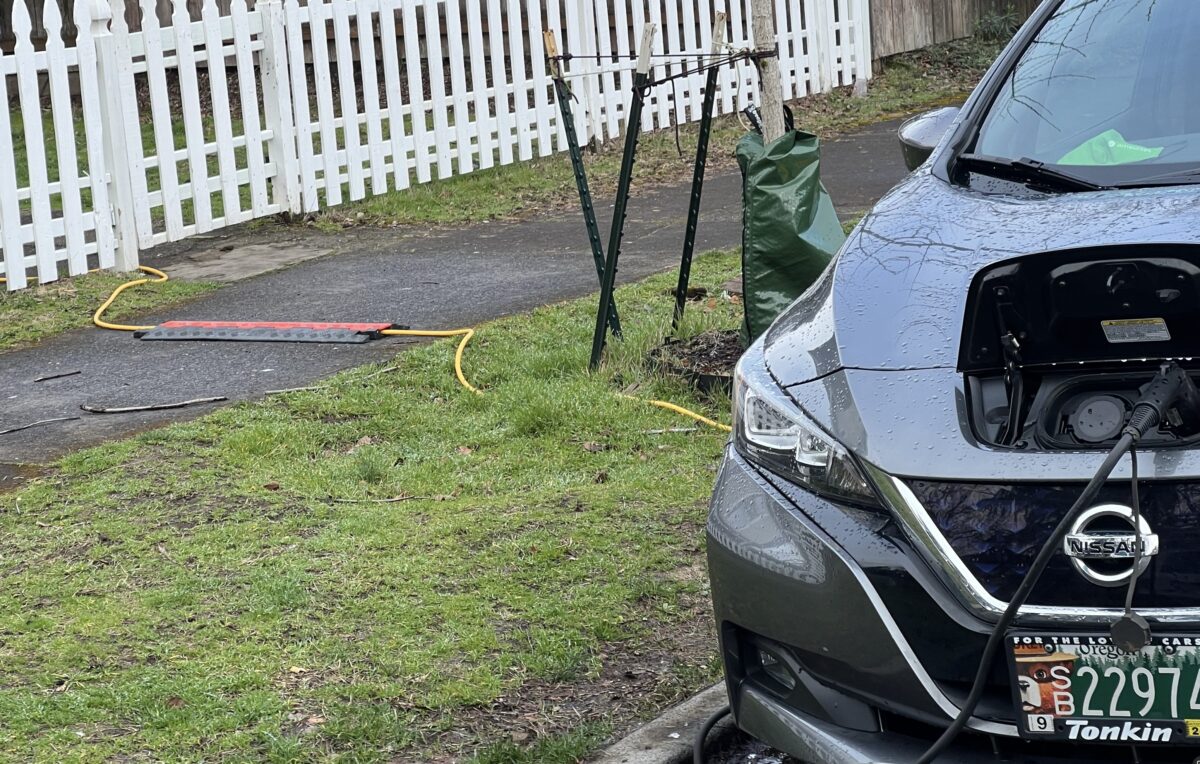
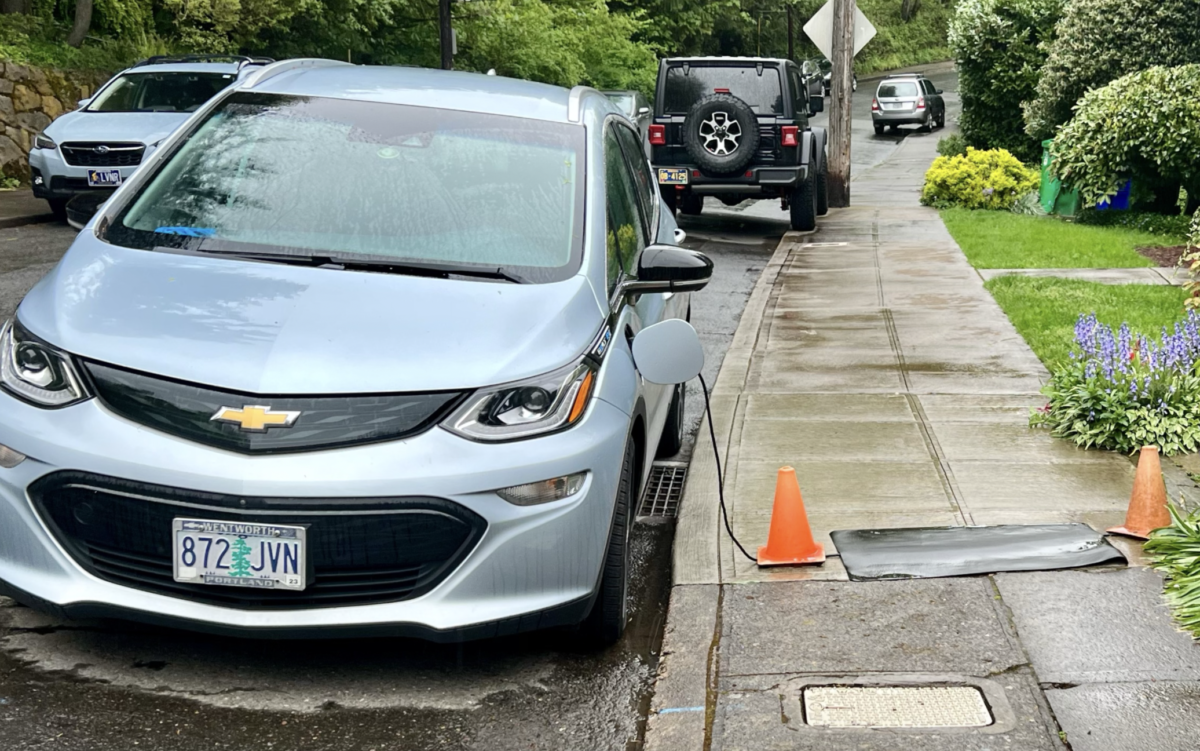
Curbside charging with a cord is now allowed without a permit, but only if certain conditions are met.
As electric cars become more and more popular, you may have the experience of walking along a Portland sidewalk and stumbling upon (maybe literally) a cord running from someone’s Tesla or Chevy Bolt to an outlet on their porch.
This situation might strike some walkers as irritating: isn’t there enough to worry about tripping over on Portland’s sidewalks, what with the pavement cracks and those little toy ponies some people tie to the metal rings outside their homes? (Hey, I’m just kidding. I love those horses.) And let’s not forget that for many people, bicycling on the sidewalk is the safest option.
Irritating as it may be, city policy does allow electric vehicle (EV) charging cords in the sidewalk right-of-way in certain circumstances. In 2021, Portland City Council approved an amendment to the Portland Bureau of Transportation’s Encroachment Manual to allow people who meet some requirements to charge their cars curbside, as long as the cords have an ADA compliant cord cover and “do not become nuisances.”
We’ve seen these cords popping up more often lately so let’s learn a bit more about the rules that govern them…
Prior to this amendment, the Encroachment Manual only allowed for landscaping and planter boxes to enter into the right-of-way, and people were required to seek a permit from the city in order to utilize this area. Curbside charging with a cord cover is now allowed by right (no permit is required) if residents meet all the following requirements:
- The residence must be located in a Single-Dwelling Residential Zone. Information and maps on zoning designations can be found at Portland Zoning.
- The residence must be located on a street classified a a Local Service Traffic Street. Information and maps on street classifications and the Portland Transportation System Plan can be found at PBOT TSP Classifications.
- The sidewalk area adjacent to the residence must have a running grade of ten percent (10%) or less. Information about Portland topography may be referenced to determine compliance with running grade requirement and is available online at ArcGIS.
- The residence must not have any off-street parking, such as a driveway or garage.
People who don’t have garages or other off-street parking facilities on their property would have a difficult time charging their electric cars if this policy weren’t in place. Still, the obstruction may be unpleasant for sidewalk users — especially people who use wheelchairs or other mobility devices to get around.
Earlier this month, Portland City Council directed PBOT to create rules to allow installation of electric car chargers in the public right-of-way to make it easier for people to use electric vehicles if they don’t have charging capacity at home. This is particularly meant to assist people who live in multi-unit dwellings by creating a reliable affordable public charging network. According to the rules of this ordinance, the EV charging stations in the right of way must not “present impediments to safe and efficient pedestrian passage, nor hinder ADA access.” The ordinance requires a minimum of a three-foot pedestrian through zone to be maintained, but a six-foot through zone is preferred.
“The installation of EV chargers shall minimize impacts and not conflict with other right-of-way users, including pedestrians, bicyclists, public transit riders, and others,” the ordinance states.
This is different from the encroachment rules, which enable EV cords to run across the pedestrian through zone without providing a passage.
In my opinion, it’s good to allow more people to charge their electric vehicles — if city and state policies are going full speed ahead with the EV embrace, at least they shouldn’t be restricted to people who have garages to charge them in.
On the other hand, Portland dedicates so much space to car storage, and this rule just allows them to cut in even more. I am excited about local programs hoping to take back curb zone space from cars and plant trees there instead, and if the city would do more of this — a la Amsterdam, where thousands of street car parking spaces have been overhauled and replaced with bike parking and playgrounds — EV cords in the pedestrian right-of-ways wouldn’t be such a big deal.
What do you think of this policy? Have you ever been bothered by an EV cord on the sidewalk? Let us know.



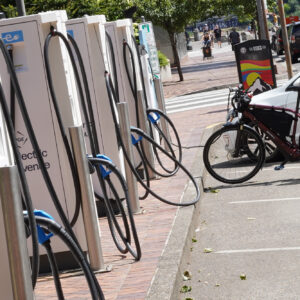

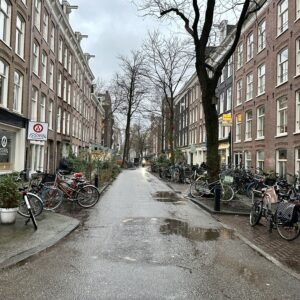
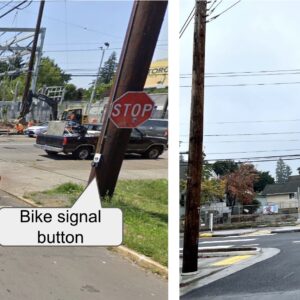
Thanks for reading.
BikePortland has served this community with independent community journalism since 2005. We rely on subscriptions from readers like you to survive. Your financial support is vital in keeping this valuable resource alive and well.
Please subscribe today to strengthen and expand our work.
Taylor,
Did you know PBOT has a 5 year backlog to inspect a reported sidewalk hazard?! I can’t imagine they would do anything about a noncompliant extension cord.
They may not charge the owners with a violation, but I have a friend who plugged in his car with a cord across the sidewalk, and his car got charged.
Wow, what was his car charged with? Battery?
“And let’s not forget that for many people, bicycling on the sidewalk is the safest option.”
Except on streets like 82nd, this assertion is categorically false. Unless you are traveling at very low speeds, bicycling on the sidewalk is dangerous for cyclists and for everybody else.
Please don’t do it.
Yes Watts, why assume I would ever think bicycling fast on sidewalks is good? Obviously if people ride on sidewalks it should be done with extreme caution. But the idea that it’s “dangerous for cyclists and everybody else” I completely disagree with. What about kids riding in their neighborhood? Sidewalks are often best for that. And many major arterials in east Portland where the bike lanes are totally inadequate and offer no protection? The sidewalk is a wonderful option that should be encouraged more IMO until better quality bikeways are built.
I don’t know what you think, because you didn’t write the story. But the story says “And let’s not forget that for many people, bicycling on the sidewalk is the safest option.”
If “many people” mean small kids, then maybe the statement is defendable. If it is only referring to very special and limited situations, then maybe it’s true.
But generally, riding on the sidewalk is dangerous. Isn’t that a well established widely accepted fact?
Well since it could mean that, and it would be defendable if it did, it’s a true statement.
But besides kids, it’s just a plainly true statement. I ride on the sidewalk frequently. Often there is an obstacle or a stretch of road with no bike lane near my destination, etc. I’m not going to ride out on a busy road or get off and walk a block for no reason. It’s safe and legal to ride on the sidewalk.
Don’t get salty just because someone pointed out how disingenuously it was worded. The defensiveness here is just off the charts sometimes.
Riding bikes on the sidewalk at walking speed where it is legal, especially if there are no pedestrians, is often the safest way to get around. Especially if I have to go the opposite way on a one way, and/ or if I am mid block and have to get to the corner. Or if I am with kids and I have to move one block over (Or less because the streets aren’t aligned.) I don’t know why anyone would have an issue for me to exercise my legal right that doesn’t impact anyone.
I fully concede that sidewalk riding, even at high speeds, is completely legal outside of the downtown areas where it is not. This is not relevant to whether or not it is safe as it is commonly done. It is not.
I am not saying that there are never circumstances where riding on the sidewalk is the best choice, but as a general statement, it is dangerous and should be discouraged.
A general statement would be if it said “it’s always safe for everyone to ride on the sidewalk at any speed”. What was actually written was a much more specific statement and could only be interpreted wrong deliberately.
“And let’s not forget that for many people, bicycling on the sidewalk is the safest option.”
You say that is a unambiguously specific statement. Ok, who or what does that statement specifically refer to? All I see is “for many people”, which is a pretty broad and general reference.
First, your assessment of “safest” is true for the cyclist only. For the overall movement of people, all it does is move the traditional conflict between heavy and light modes of transport from cars vs. bicycles to bicycles vs. pedestrians.
Second, if this is a sidewalk that is commonly used by bicycles, it’s likely there are no pedestrians because the bicycles have scared them away. Your actions may have inconvenienced people whose mode of transport is much slower than yours, and your interpretation that “no pedestrians” use that sidewalk is both self-centered and self-fulfilling.
Third, the idea that the need to follow laws is situational is a recipe for anarchy. Is it OK for cars to ignore stop signs if they “know” there are no cars coming the other way? How many bicyclists follow the “walking speed” law on sidewalks if they don’t see any pedestrians? And how many pedestrians know that they are at risk of a collision with a bicycle when stepping onto an empty sidewalk?
I bicycled over 10,000 miles a year for years, until I was scared off the road the complete disregard of one class of traveler for all the others. The best approach to surviving to a ripe old age is to get the idea that you are a vehicle firmly in your head. You can bike over another block and go the right way on a different street. Suck it up.
BTW, if you read my “scared” comment as being scared of cars when I was on a bicycle, that’s true. But it also applies to pedestrians scared of being surprised by an oncoming bicycle coming from behind. Or one coming from ahead where neither knows which direction the other one will move to avoid a head-on collision.
Again, suck it up. You have two perfectly good legs, or you wouldn’t be riding. So do your kids. If the inconvenient distance is short, dismount and walk. If it is long, find a better route.
When someone starts a statement asserting rights with the statement “I don’t know why anyone would have an issue”, what they’re generally saying is “I really don’t care about anyone else’s situation or point of view”. I suggest you spend a week walking around on sidewalks outside of the business district to get a pedestrian’s perspective. Or, for a real perspective change, try a wheelchair.
When on two wheels, I have always tried to bike safely and fit seamlessly into whatever traffic I’ve encountered. I’ve been on the receiving end of the not-unjustified anger that drivers feel toward entitled cyclists who feel that the only laws that apply to them are the ones that protect them, and that they are free to ignore any laws that might add a couple of minutes to their commute. I’ve watched cyclists spit at drivers through open sunroofs and speed away down sidewalks where they couldn’t be followed, and I was glad that I wasn’t the next cyclist that driver encountered.
We try to treat the roads (and sidewalks) as if they weren’t an adversarial situation, but in many cases they are. There are more modes of transportation than there are dedicated rights-of-way, so sharing is inevitable. Sharing requires accommodation, something I’ve seen everybody ignore, regardless of their transportation mode or the specific situation.
A solution to this problem is necessary, but promoting cyclists from the lowest to the highest in the food chain by moving them out of automobile traffic and onto the sidewalk ain’t the way.
Thank you
Why are you going the wrong way down a one-way…. Is It that hard to go one street over
I can ride a 2 wheeler at well under 2mph, and in the 2 cases where I ride on a sidewalk I go the speed of the pedestrian in front of me. On my trike I can go even slower obviously.
I do this because crossing to the sidewalk at an intersection with a signal, then turning left into the property without crossing a busy street is *vastly* safer than trying to move from the bike lane to the vehicle lane then *sit* there with cars coming up behind me until there’s a big enough break in oncoming traffic to cross.
So I will ride on the sidewalk if it’s the safest way to get where I’m going, thank you.
Of course. Everyone defending the practice is doing so by citing edge cases, such as when little kids do it, or riding a quarter block to access a driveway, or riding at 2mph. Yes, fine, not dangerous. Go for it.
But the statement I objected to sounded much more general than that. And, in the general case, sidewalk riding is dangerous.
They should already be looking down, you know how am y sidewalks are uneven?
Not really getting into if it creates more obstructions or not, it definitely shows that the city can easily create new rules for the things they want the other “haves” to have. When the council or their subordinate bureaucracies dither on why they can’t do something productive that would be helpful its clear that they just don’t want to.
Frustrating that we are moving forward with charging facilities in the public right of way. I get that people need EV charging infra, but I think chargers should be more like gas-station like locations than anything else. Obstructing the right of way with chargers is bad – even if EV adoption is a reasonably good goal.
I’m also not sure on the 3 foot width. The PBOT Pedestrian guide shows minimums of 6 feet for all corridor types (wider for “main streets”). 3 feet is noted in that guide as being too narrow for mobility devices, and almost too narrow for a person to walk comfortably through (they give 2.5 feet as a typical person’s walking width).
It’s ridiculous that EV chargers (for cars) are allowed to encroach on the pedestrian right of way at all. They really should be mandated to be on the street – at least we could use this opportunity to narrow some local roads that are already too wide. But no, Johnny Pedestrian will have to suffer again.
Not all renters have access to grounded plugs but many of those that do use these kinds of hacks to charge their vehicles. It’s weird that you object to something that is only present a few tens of hours per month when so many homeowners permanently block the right of way with bushes and shrubs. City code also requires that cables be covered with negotiable (and detectable) cable covers/blankets.
Why can’t folks go to dedicated charging stations?
Public charging stations typically cost 40+ cents per kwh vs ~12 cents per kwh to charge at home. Renters won’t replace their fossil-sludge-burning cars with an EV if it’s cheaper to fill up a tank. Moreover, a city where only homeowners with driveways are entitled to cheap at-home EV charging is one that further perpetuates class- and race-based disparities in transportation costs.
One of the reasons why it’s usually the haves pushing EVs.
The “haves” also ensure that there are all sorts of subsidies for EVs that almost entirely go to their class.
What race disparities in transportation costs, be specific with real-world examples.
I agree blumdrew, car infrastructure should be in the street. Here’s how Paris does it:
Another anti-renter position.
Why do I even bother posting here?
Another ableist assumption about what people can step over . . . but why do I even bother?
Another ableist assumption that people in wheelchairs don’t need cars to get around efficiently and that bikes and walking are preferred and “easy”.
Bill, I’m disabled. I’m not using a wheelchair, but those cords would be impediments for me walking.
Portland has done things “on the cheap” for a century. Can’t you imagine, fifty years from now, a nice graphic (a la the sidewalk coverage by annexation date map) showing that some neighborhoods got built before the advent of electric cars, and therefore have to use extension cords to charge up?
It will be another Portland can kicked down the road for a century.
To be fair, most cities aren’t doing anything to improve charging infrastructure. Supposedly L.A. has street chargers attached to streetlight poles. Sounds like a good solution, but local governments need to be aware of cost of electricity. $0.38 per kWh is roughly the equivalent price of electricity for gasoline for 3.8 miles per kWH vs low 40 mpg in ICE. Yet I see lots of chargers with rates in the $0.50 range. Public L2 chargers should be in the $0.20 to $0.30 / kWh range to offset higher cost of EVs.
Come on. “Car infrastructure should be on the street” is not anti renter. It’s just true. Sidewalks are for people. The fact that rentals don’t give you a separate way to charge your car is a separate problem that is important and needs to be addressed. Stuff like cords across the sidewalk are an ok but problematic temporary bandaid on the fact that EVs are new and we don’t have a better approach now. For sidewalk users, i.e. people, adding a tripping hazard / rolling obstacle is not an acceptable long term solution.
Good question.
I’m sorry, but everyone I see running cords across sidewalks in FoPo meets the criteria and puts covers over the cords so bikes and wheelchairs can easily get over them. If that constitutes “suffering” for you on you walk, that sounds like a you problem.
The thing is, it is a “you” problem. Disability is not a binary, you’re walking just fine or on wheels.
Some people can walk, just not very well. Neurological problems, balance issues, foot drop, age can all lead to someone having trouble walking on anything but a flat, smooth surface–like a sidewalk. So yeah, cords taped across the r.o.w., debris, cars encroaching on the sidewalk can cause problems for some disabled people.
I hear your point, but honestly there is no sidewalk in any major city that perfectly meets that definition. My own father had Parkinson’s and he very much struggled with navigating sidewalks with obstacles. Was hard for him to get over small berms for years. But he never would have considered these thoughtfully placed and temporary cords to be somrthing he should seek to ban others from having. He would have recognized that there are tradeoffs when living in a city together with other people and that his condition wasn’t a reason to criticize or limit reasonable behavior by others. If we want more people to use electric vehicles, then people need convenient places to charge them. I’m not sure what you want someone without a driveway to do? They need to get a cord to the car. It is what is it.
I hear you MG, clearly you are an experienced hand with disability.
I’ve organized the neighborhood block party for twenty years. That event is so crucial to smooth neighborhood relations! But some people are pretty clueless about keeping their sidewalk clear. Stepping over a garden hose requires attention and care on my part. So I had to talk to my neighbor who couldn’t ever manage to pull her car completely into her driveway, necessitating me to step over the clogged stormwater drain in front of her house, into the street, and then back up the curb again. Another ten steps over to the woman with about a quarter inch of seed pods on her sidewalk – now those will land you on your ass. What can I say, it all adds up to maybe deciding not to go on a walk after all.
It makes sense to me to allow this.
It makes me wonder about all the hundreds of locations where restaurants ran (and still do) power cords across sidewalks to lights, heaters, speakers, etc. in their parking-space outdoor seating areas. Were those ever (or are they now) legal? They didn’t bother me, either, if done correctly (with a cord cover). And those were in much higher sidewalk traffic areas.
The cords are common enough in the winter in the northern states, for engine block heaters rather than for EVs – many apartments and homes even have external outlets near the street or in parking lots for just that purpose.
Seems like it would be easy to do a small cut in the existing sidewalk slab and replace with a poured (or even pre-fab) recessed channel. Put a metal grate on top.
Too bad, once again, we’re taking the half-assed do-nothing approach instead of pioneering a solution. Nothing says “performatively progressive” like the City of Portland.
I found another homeowner!
My landlord won’t approve installation of fiber internet but I’m sure they will let me dig up their sidewalk and install a metal grate charger conduit.
Not every potential solution needs to solve 100% of the problem.
The cutting would not be hard: you could use a circular saw and a concrete cutting blade. Then cold chisel out the waste.
But fitting a metal grate might be tough for a DIYer, if the goal is to keep the walking/riding surface smooth. Part of the challenge would be the cross-trade nature of it- it’s a metal fabrication job *and* a concrete cutting job.
I’d say that if your suggestion were code, it would add some up front investment cost to the use of an EV. Not insurmountable! But I’d rather we get the gas cars off the road sooner.
I did this at my residence in New Jersey. It wasn’t that difficult. Only issue is that I occasionally hear the metal plate clank.
Plumbers putty (or uv resistant alternative) could help with that.
I live in a SF home but don’t have a driveway (or an EV), but if I did (have a driveway), I would run a cord with a little flattener on it so people wouldn’t trip. There are, on the other hand, at least 5-6 abandoned cars on my street that parking enforcement has not deemed enough of a priority to ticket or remove despite repeated reporting. Many cars also park in the wrong direction on my street which I feel is more of a safety hazard to bikes and pedestrians. I’ve lived in Belgium/The Netherlands and it’s honestly pretty low density in most places. I do love their bike culture (I was a formerly bike/ped advocacy planner mostly inspired by my time living there) but it’s not that similar to the US. Portland was the closest the US had until recent years. We’ll get back there.
Compared the stuff we have to navigate while walking on the sidewalks, I feel that a cord is NBD.
I have yet to see an “ADA compliant” cord cover in use on a sidewalk in Portland. You can easily find the narrow, abrupt-slope ones, but one that’s suitable for wheelchair use (ADA) is much more gentle slope, making a very large ramp. (see photo)
I believe ADA compliant ramps are a 12:1 ratio for slope, so to get over a 1″ cord, you’d need at least 12″ of horizontal space on each side. Likely more since the cover itself has thickness. That picture above seems about right, probably need nearly 30″ of ramp. I’ve never seen one of those on the sidewalk either.
Good point. After your post, I’ve been noticing, and I actually did see one at Pioneer Square over a cord connecting to a food cart.
The new rule does require them, but the chances are slim that anyone would install one, or even realize that whatever cover they buy at Home Depot isn’t automatically ADA compliant. I wouldn’t be surprised if even the City doesn’t know that not all covers are compliant. They certainly weren’t requiring (or at least being aware of) them over cords to in-street restaurant dining shelters.
Is that Jeep parking on the curb legal?
I would like to see it require commercial grade cord protection if it’s more than an hour i.e. Iike the rv in the article vs the car. (An hour? Because emergencies happen. If it’s a friend’s house, hopefully that will get you the 5 minutes to a commercial charger)
Encourage less on property parking? Probably a good thing. Driveways are rarely used. With road use, you can have a narrower road resulting in calmer traffic. Curb bulbs can guide pedestrians into the road without worry of another lane of traffic. These can have additional green features… trees, and plants. In addition to the yard space now having more green vs runoff space (or denser living) all probably a desired feature for people most likely using ev’s. If you move into such a neighborhood, that’s your interest and goal.
A requirement? Idk, but an option made available with the law for developers and existing owners in such neighborhoods.
P.s./i.e. driveway with narrow road vs no driveway and minimal curb parking with road diet features. Sure you might have a guaranteed parking spot if you have a driveway, but they will probably still take up more space and provide less green space (or less density) than limited street spots.
what’s the problem?
no one going to trip over them ! (the cord).
EV is for everybody rich or poor !
Is it legal for bike riders to ignore stop signs?
Sort of.
Also red lights as long as “it looks clear”…All Yield signs. One-way streets. Making proper turn signals. Not wearing a helmet.
This kind of thing is my favorite because it shows just how insane leftist policy is.
Portland is one of the most left places in the nation, so it’s a good bet that it’s generally in favor of a ban on ICE vehicles. But you’re also pissy about the cheapest and most convenient charging options available for EV’s.
The only solution is being wealthy enough to both buy an EV and own a garage to charge in.
Leftist policy makes it as hard as possible to be in the lower half of the socioeconomic spectrum. Then blames capitalism for the problems created by leftist government.
The other solution is for the city to build charging stations in the street, like other cities do. See photo of Paris in thread.
Only a Portland leftist would be so detached from the reality of working class Portlanders that they would believe private charging stations that are far more expensive per mile than filling up a car with gasoline as any kind of solution. What have working class people done to you to deserve this kind of passive aggressive disdain?
This kind of post is my favorite because it shows the author’s idea of “leftist policy” is entirely a strawman creation untethered in reality. Though hardly an unsurprising or uncommon one, given how much capital is invested in perpetuating such.
Your comments don’t seem to relate to the information in the article.
You say, “The only solution is being wealthy enough to both buy an EV and own a garage to charge in” in response to an article about the City realizing that people without garages can’t charge their cars in the street without violating sidewalk regulations, so they changed the law to accommodate that–two years ago!
Or, if by “leftists”, “Portland” and “you” you don’t mean City government or general population, but instead mean the one person out if half a million people here who wrote this article, and view them as representing the feelings of the everyone here, note that they explain why allowing this charging was needed and is reasonable.
She even wrote, “If city and state policies are going full speed ahead with the EV embrace, at least they shouldn’t be restricted to people who have garages to charge them in”–the exact opposite of the view you’re complaining about.
The article does include criticisms, but they’re given in context–that the cords are a result of using street space for car parking that other cities have benefited from removing, and that if/when that happens here, the cords-across-sidewalks situation will be minimized.
What does any of that have to do with “leftist” policies harming people or blaming capitalism?
Another lib elitist who ignores the fact that private on-street EV charging sites are so expensive that they function as massive barrier to EV adoption by working class people.
Why would the state care anyway, you know how many sidewalks are bent out of shape already and are easily trippable
Let’s not forget that bicycling on the sidewalk is also illegal and you’re supposed to use the road…… Also as someone who’s not from Portland what in the actual heck is little toy pony on the ring outside someone’s house
If you have an EV, park on the street and have no place to charge it [Moderator: deleted phrase]. Any insurance company will not allow cords to cross a sidewalk.
In July last year, I started on Parkinson’s disease TREATMENT PROTOCOL from Natural Herbs Centre (ww w. Naturalherbscentre. com). One month into the treatment, I made a significant recovery. After I completed the recommended treatment, almost all my symptoms were gone, great improvement with my movement and balance. Its been a year, life has been amazing
BIKES HAVE BIKE LANES BIKES SHOULD NOT BE ON SIDEWALKS. – HARD STOP.
If you have an EV, you must use a cable hump or cable management system. That simple. Easy & safe. This is not rocket science.